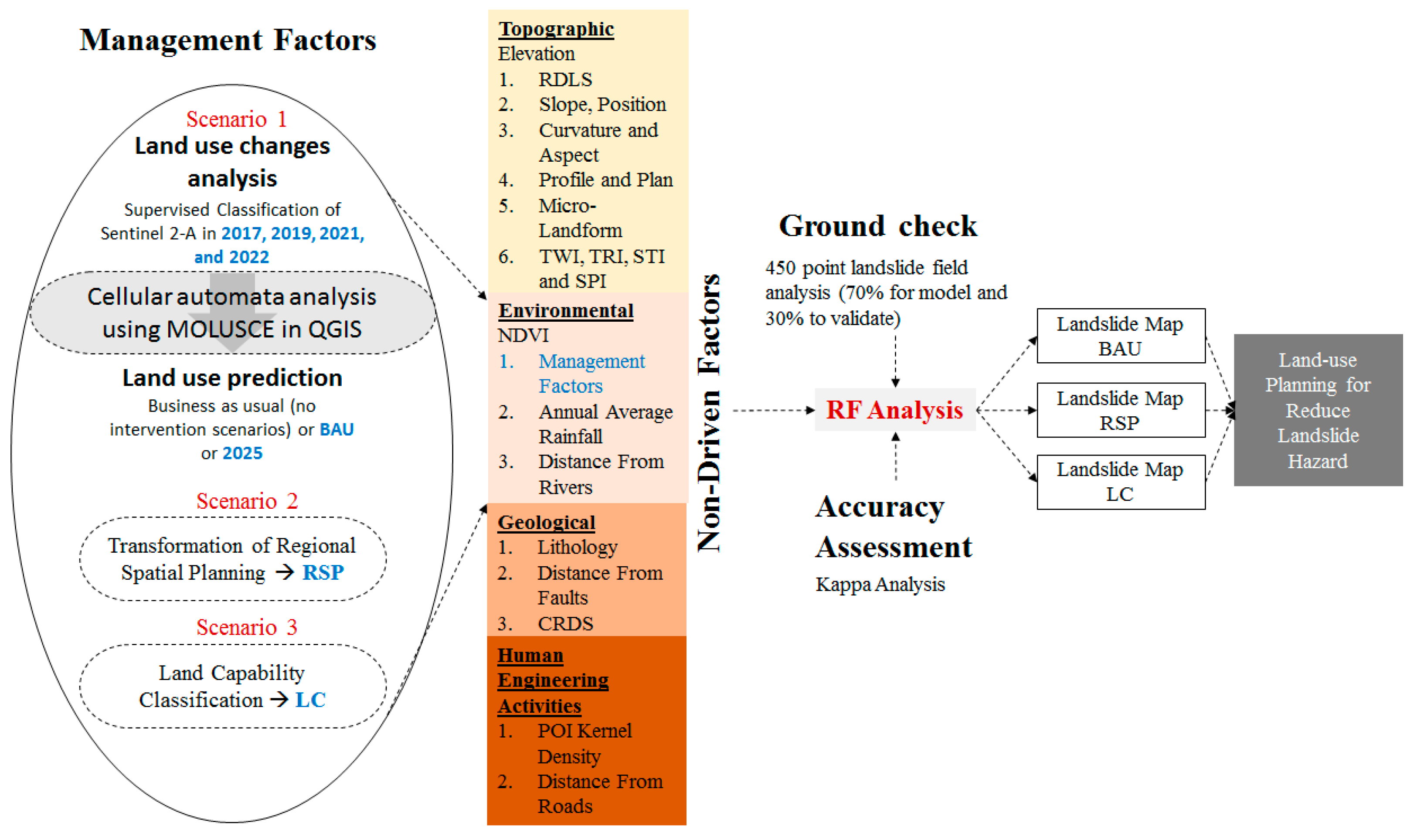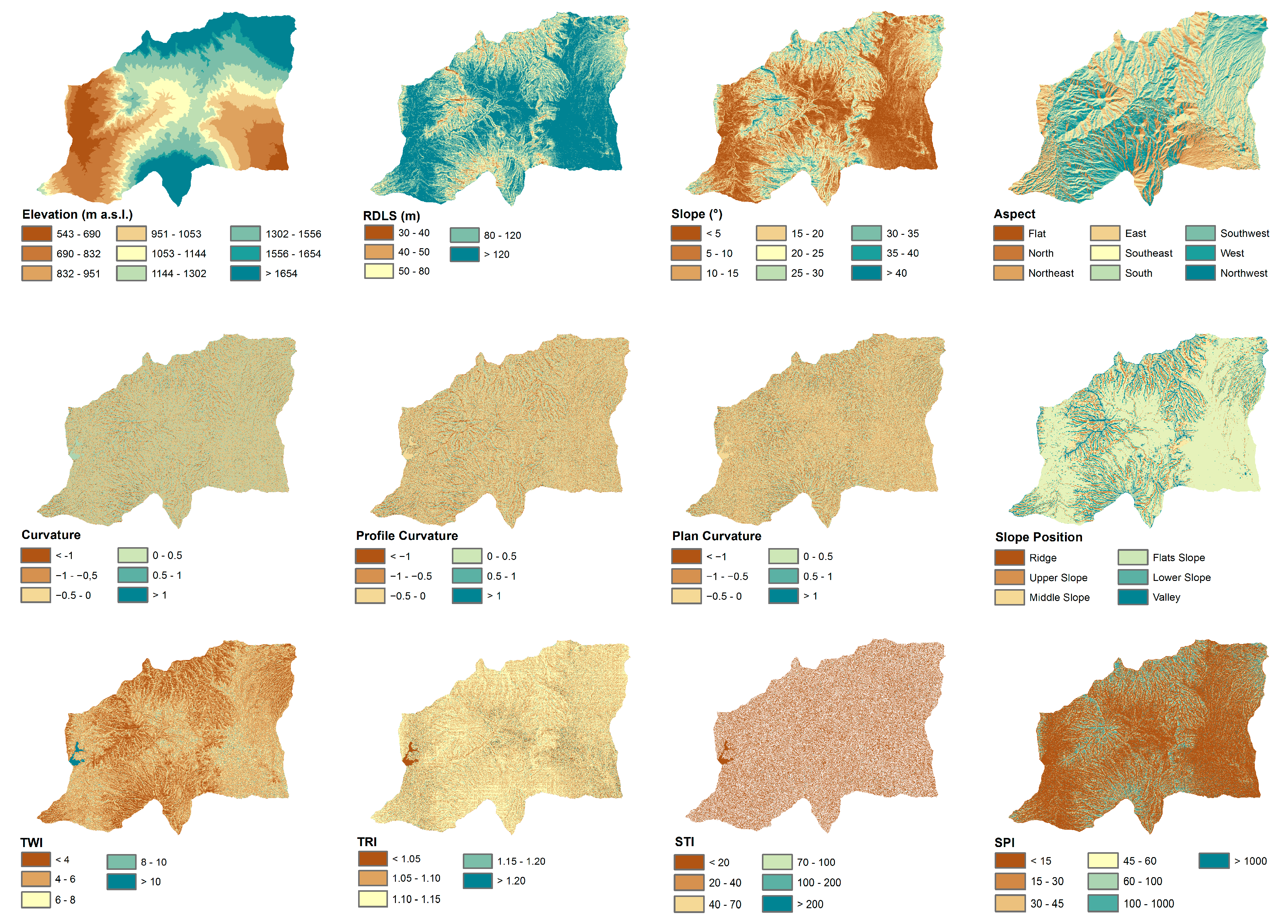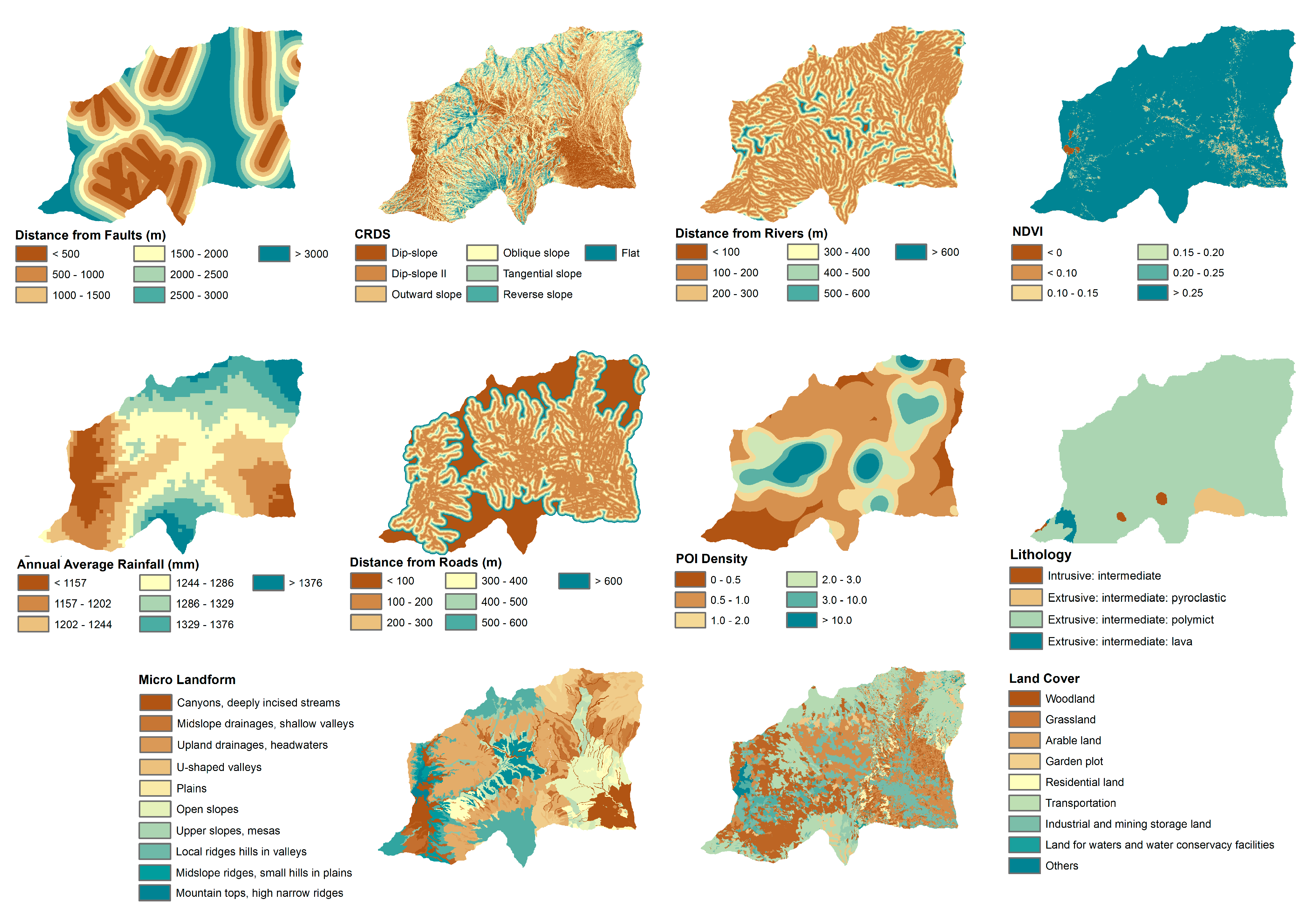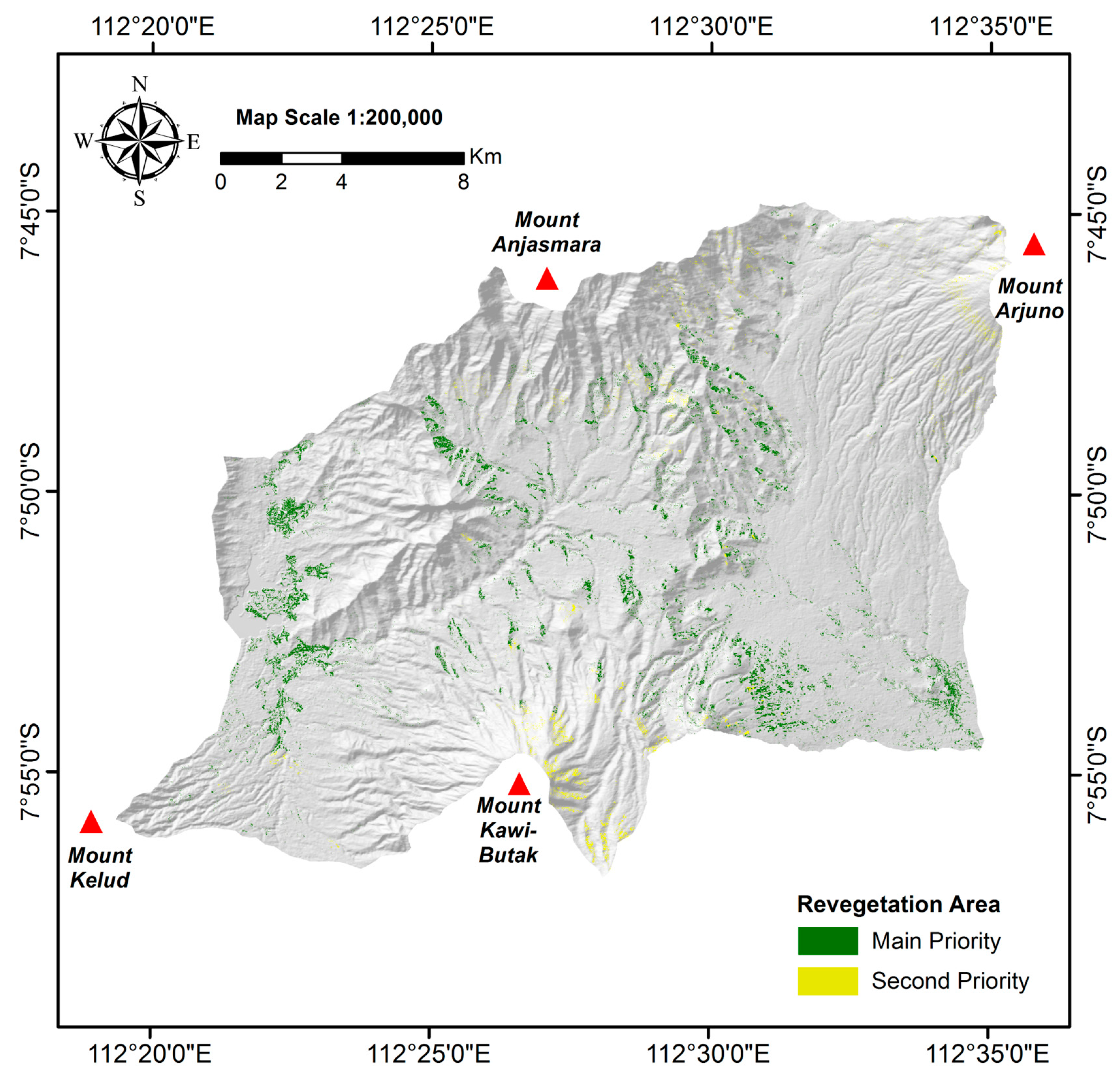Utilizing Remote Sensing and Random Forests to Identify Optimal Land Use Scenarios and Address the Increase in Landslide Susceptibility
Abstract
1. Introduction
2. Materials and Methods
2.1. Study Area
2.2. Research Framework
2.3. Land Use Classification
2.3.1. Business as Usual Scenario Prediction
2.3.2. Regional Spatial Planning Scenario
2.3.3. Land Capability Class Scenario
2.4. Landslide Predictor Parameter
2.5. Random Forest Landslide Susceptibility Modeling
2.6. Landslide Classification
2.7. Validation of Landslide Map
3. Results
3.1. Land Use Changes in the Sumber Brantas and Kali Konto Sub-Watersheds
3.2. Land Use Management Scenario
3.3. Driving Parameters for Landslide Susceptibility
3.4. Distribution of Landslide Level Based on Land Use Scenarios
3.5. Distribution of Landslide Hazards Based on Land Use Scenarios
3.6. Accuracy Assessment
4. Discussion
4.1. The Influence of Land Use on Landslide Susceptibility
4.2. Best Scenario in Landslide Susceptibility Mitigation
4.3. Recommendations for Revegetation Areas
4.4. Potential Use of the Model to Predict Landslide
5. Conclusions
Author Contributions
Funding
Institutional Review Board Statement
Informed Consent Statement
Data Availability Statement
Acknowledgments
Conflicts of Interest
Abbreviations
| BAU | Business as Usual |
| LCC | Land Capability Class |
| RSP | Regional Spatial Planning |
| CA | Cellular Automata |
| ANN | Artificial Neural Network |
| RF | Random Forest |
| LULC | Land Use Land Cover |
References
- Tateishi, H.R.; Bragagnolo, C.; Almeida, A.N. Forest, agriculture and land conversion: Environmental efficiency in Brazilian Amazon rainforest. For. Policy Econ. 2021, 133, 102615. [Google Scholar] [CrossRef]
- Khan, M.M.H.; Bryceson, I.; Kolivras, K.N.; Faruque, F.; Rahman, M.M.; Haque, U. Natural disasters and land-use/land-cover change in the southwest coastal areas of Bangladesh. Reg. Environ. Chang. 2015, 15, 241–250. [Google Scholar] [CrossRef]
- Dewi, S.; van Noordwijk, M.; Ekadinata, A.; Pfund, J.-L. Protected areas within multifunctional landscapes: Squeezing out intermediate land use intensities in the tropics? Land Use Policy 2013, 30, 38–56. [Google Scholar] [CrossRef]
- Chen, D.; Wang, C.; Li, Y.; Liu, X.; Wang, Y.; Qin, J.; Wu, J. Effects of land-use conversion from Masson pine forests to tea plantations on net ecosystem carbon and greenhouse gas budgets. Agric. Ecosyst. Environ. 2021, 320, 107578. [Google Scholar] [CrossRef]
- Hallaj, Z.; Bijani, M.; Karamidehkordi, E.; Yousefpour, R.; Yousefzadeh, H. Forest land use change effects on biodiversity ecosystem services and human well-being: A systematic analysis. Environ. Sustain. Indic. 2024, 23, 100445. [Google Scholar] [CrossRef]
- Saco, P.M.; McDonough, K.R.; Rodriguez, J.F.; Rivera-Zayas, J.; Sandi, S.G. The role of soils in the regulation of hazards and extreme events. Philos. Trans. R Soc. B Biol. Sci. 2021, 376, 1834. [Google Scholar] [CrossRef]
- Suprayogo, D.; Prayogo, C.; Saputra, D.D.; Sari, R.R.; Putra, A.N.; Hadiwijoyo, E.; Andhika, Y.; Ishaq, R.M.; Purnamasari, E.; Irawan, D.B. The capacity of community on running soil and water conservation in Bangsri micro-catchment, Upper Brantas Watershed, Indonesia. IOP Conf. Ser. Earth Environ. Sci. 2019, 393, 012054. [Google Scholar] [CrossRef]
- Muñoz-Torrero Manchado, A.; Antonio Ballesteros-Cánovas, J.; Allen, S.; Stoffel, M. Deforestation controls landslide susceptibility in Far-Western Nepal. Catena 2022, 219, 106627. [Google Scholar] [CrossRef]
- Setiawan, B.; Sudarto, S.; Putra, A.N. Mapping of landslide-prone areas in Pujon District using the Analytic Hierarchy Process (AHP) method. J. Tanah Dan Sumberd. Lahan 2017, 4, 567–576. (In Indonesia) [Google Scholar]
- Popp, A.; Calvin, K.; Fujimori, S.; Havlik, P.; Humpenöder, F.; Stehfest, E.; Bodirsky, B.L.; Dietrich, J.P.; Doelmann, J.C.; Gusti, M.; et al. Land-use futures in the shared socio-economic pathways. Glob. Environ. Chang. 2017, 42, 331–345. [Google Scholar] [CrossRef]
- Kalsnes, B.; Capobianco, V. Use of vegetation for landslide risk mitigation. In Climate Adaptation Modelling; Springer International Publishing: Cham, Switzerland, 2022; pp. 77–85. [Google Scholar] [CrossRef]
- Sinčić, M.; Bernat Gazibara, S.; Krkač, M.; Lukačić, H.; Mihalić Arbanas, S. The use of high-resolution remote sensing data in preparation of input data for large-scale landslide hazard assessments. Land 2022, 11, 1360. [Google Scholar] [CrossRef]
- Li, L.; Xu, E. Scenario analysis and relative importance indicators for combined impact of climate and land-use change on annual ecosystem services in the Karst mountainous region. Ecol. Indic. 2023, 147, 109991. [Google Scholar] [CrossRef]
- Mousavi, S.M.; Roostaei, S.; Rostamzadeh, H. Estimation of flood land use/land cover mapping by regional modeling of flood hazard at sub-basin level case study: Marand basin. Geomat. Nat. Hazards Risk 2019, 10, 1155–1175. [Google Scholar] [CrossRef]
- Saing, Z.; Djainal, H.; Deni, S. Land use balance determination using satellite imagery and geographic information system: Case study in South Sulawesi Province, Indonesia. Geod. Geodyn. 2021, 12, 133–147. [Google Scholar] [CrossRef]
- Dash, P.; Sar, J. Identification and validation of potential flood hazard area using GIS-based multi-criteria analysis and satellite data-derived water index. J. Flood Risk Manag. 2020, 13, e12620. [Google Scholar] [CrossRef]
- Ma, S.; He, L.; Fang, Y.; Liu, X.; Fan, Y.; Wang, S. Intensive land management through policy intervention and spatiotemporal optimization can achieve carbon neutrality in advance. J. Clean. Prod. 2023, 385, 135635. [Google Scholar] [CrossRef]
- Astuti, I.S.; Sahoo, K.; Milewski, A.; Mishra, D.R. Impact of land use land cover (LULC) change on surface runoff in an increasingly urbanized tropical watershed. Water Resour. Manag. 2019, 33, 4087–4103. [Google Scholar] [CrossRef]
- Hairiah, K.; van Noordwijk, M.; Sari, R.R.; Saputra, D.D.; Widianto; Suprayogo, D.; Kurniawan, S.; Prayogo, C.; Gusli, S. Soil carbon stocks in Indonesian (agro) forest transitions: Compaction conceals lower carbon concentrations in standard accounting. Agric. Ecosyst. Environ. 2020, 294, 106879. [Google Scholar] [CrossRef]
- Stoeglehner, G.; Abart-Heriszt, L. Integrated spatial and energy planning in Styria—A role model for local and regional energy transition and climate protection policies. Renew. Sustain. Energy Rev. 2022, 165, 112587. [Google Scholar] [CrossRef]
- Wei, Y.M.; Kang, J.N.; Liu, L.C.; Li, Q.; Wang, P.T.; Hou, J.J.; Liang, Q.M.; Liao, H.; Huang, S.F.; Yu, B. A proposed global layout of carbon capture and storage in line with a 2 °C climate target. Nat. Clim. Chang. 2021, 11, 112–118. [Google Scholar] [CrossRef]
- Jenerowicz, A.; Wierzbicki, D.; Kedzierski, M. Radiometric correction with topography influence of multispectral imagery obtained from unmanned aerial vehicles. Remote Sens. 2023, 15, 2059. [Google Scholar] [CrossRef]
- Wang, J.; Yang, D.; Chen, S.; Zhu, X.; Wu, S.; Bogonovich, M.; Guo, Z.; Zhu, Z.; Wu, J. Automatic cloud and cloud shadow detection in tropical areas for PlanetScope satellite images. Remote Sens. Environ. 2021, 264, 112604. [Google Scholar] [CrossRef]
- Yin, F.; Lewis, P.E.; Gómez-Dans, J.L. Bayesian atmospheric correction over land: Sentinel-2/MSI and Landsat 8/OLI. Geosci. Model Dev. 2022, 15, 7933–7976. [Google Scholar] [CrossRef]
- Rwanga, S.S.; Ndambuki, J.M. Accuracy assessment of land use/land cover classification using remote sensing and GIS. Int. J. Geosci. 2017, 8, 611–622. [Google Scholar] [CrossRef]
- Gharaibeh, A.; Shaamala, A.; Obeidat, R.; Al-Kofahi, S. Improving land-use change modeling by integrating ANN with Cellular Automata-Markov Chain model. Heliyon 2020, 6, e05092. [Google Scholar] [CrossRef]
- Hou, Y.; Yang, M.; Li, Y. Coordinated effect of green expansion and carbon reduction: Evidence from sustainable development of resource-based cities in China. J. Environ. Manag. 2024, 349, 119534. [Google Scholar] [CrossRef] [PubMed]
- Xu, Y.; Dai, Q.Y.; Zou, B.; Xu, M.; Feng, Y.X. Tracing climatic and human disturbance in diverse vegetation zones in China: Over 20 years of NDVI observations. Ecol. Indic. 2023, 156, 111170. [Google Scholar] [CrossRef]
- De Feudis, M.; Falsone, G.; Gherardi, M.; Speranza, M.; Vianello, G.; Antisari, L.V. GIS-based soil maps as tools to evaluate land capability and suitability in a coastal reclaimed area (Ravenna, northern Italy). Int. Soil Water Conserv. Res. 2021, 9, 167–179. [Google Scholar] [CrossRef]
- Adams, V.M.; Engert, J.E. Australian agricultural resources: A national scale land capability map. Data Brief 2023, 46, 108852. [Google Scholar] [CrossRef]
- Sun, D.; Xu, J.; Wen, H.; Wang, D. Assessment of landslide susceptibility mapping based on Bayesian hyperparameter optimization: A comparison between logistic regression and random forest. Eng. Geol. 2021, 281, 105972. [Google Scholar] [CrossRef]
- Pourghasemi, H.R.; Kariminejad, N.; Amiri, M.; Edalat, M.; Zarafshar, M.; Blaschke, T.; Cerda, A. Assessing and mapping multi-hazard risk susceptibility using a machine learning technique. Sci. Rep. 2020, 10, 3203. [Google Scholar] [CrossRef]
- Ngo, P.T.T.; Pham, T.D.; Hoang, N.D.; Tran, D.A.; Amiri, M.; Le, T.T.; Hoa, P.V.; Bui, P.V.; Nhu, V.H.; Bui, D.T. A new hybrid equilibrium optimized SysFor based geospatial data mining for tropical storm-induced flash flood susceptible mapping. J. Environ. Manag. 2021, 280, 111858. [Google Scholar] [CrossRef]
- Wang, Y.; Sun, D.; Wen, H.; Zhang, H.; Zhang, F. Comparison of random forest model and frequency ratio model for landslide susceptibility mapping (LSM) in Yunyang county (Chongqing, China). Int. J. Environ. Res. Public Health 2020, 17, 4206. [Google Scholar] [CrossRef]
- Hong, H.; Shahabi, H.; Shirzadi, A.; Chen, W.; Chapi, K.; Ahmad, B.B.; Roodposhti, M.S.; Yari Hesar, A.; Tian, Y.; Tien Bui, D. Landslide susceptibility assessment at the Wuning area, China: A comparison between multi-criteria decision making, bivariate statistical and machine learning methods. Nat. Hazards 2019, 96, 173–212. [Google Scholar] [CrossRef]
- Wang, Y.; Hong, H.; Chen, W.; Li, S.; Pamučar, D.; Gigović, L.; Drobnjak, S.; Bui, D.T.; Duan, H. A hybrid GIS multi-criteria decision-making method for flood susceptibility mapping at Shangyou, China. Remote Sens. 2019, 11, 62. [Google Scholar] [CrossRef]
- Sun, D.; Wen, H.; Zhang, Y.; Xue, M. An optimal sample selection-based logistic regression model of slope physical resistance against rainfall-induced landslide. Nat. Hazards 2021, 105, 1255–1279. [Google Scholar] [CrossRef]
- Sun, D.; Wen, H.; Wang, D.; Xu, J. A random forest model of landslide susceptibility mapping based on hyperparameter optimization using Bayes algorithm. Geomorphology 2020, 362, 107201. [Google Scholar] [CrossRef]
- Pham, B.T.; Nguyen-Thoi, T.; Qi, C.; Van Phong, T.; Dou, J.; Ho, L.S.; Van Le, H.; Prakash, I. Coupling RBF neural network with ensemble learning techniques for landslide susceptibility mapping. Catena 2020, 195, 104805. [Google Scholar] [CrossRef]
- Chowdhury, M.S. Modelling hydrological factors from DEM using GIS. MethodsX 2023, 10, 102062. [Google Scholar] [CrossRef] [PubMed]
- Zhou, X.; Wen, H.; Zhang, Y.; Xu, J.; Zhang, W. Landslide susceptibility mapping using hybrid random forest with GeoDetector and RFE for factor optimization. Geosci. Front. 2021, 12, 101211. [Google Scholar] [CrossRef]
- Yi, Y.; Zhang, Z.; Zhang, W.; Jia, H.; Zhang, J. Landslide susceptibility mapping using multiscale sampling strategy and convolutional neural network: A case study in Jiuzhaigou region. Catena 2020, 195, 104851. [Google Scholar] [CrossRef]
- Shirzadi, A.; Soliamani, K.; Habibnejhad, M.; Kavian, A.; Chapi, K.; Shahabi, H.; Chen, W.; Khosravi, K.; Pham, B.T.; Pradhan, B.; et al. Novel GIS based machine learning algorithms for shallow landslide susceptibility mapping. Sensors 2018, 18, 3777. [Google Scholar] [CrossRef]
- Poddar, I.; Roy, R. Application of GIS-based data-driven bivariate statistical models for landslide prediction: A case study of highly affected landslide prone areas of Teesta River basin. Quat. Sci. Adv. 2024, 13, 100150. [Google Scholar] [CrossRef]
- Saad, M.; Kamel, M.; Moftah, H. Landslide susceptibility mapping for the Red Sea Mountains: A multi-criteria decision analysis approach. J. Afr. Earth Sci. 2024, 209, 105125. [Google Scholar] [CrossRef]
- Nugroho, D.D.; Nugroho, H. Landslide vulnerability analysis using frequency ratio method in West Bandung Regency, West Java. Geoid 2020, 16, 8. [Google Scholar] [CrossRef]
- Guo, W.Z.; Luo, L.; Wang, W.L.; Liu, Z.Y.; Chen, Z.X.; Kang, H.L.; Yang, B. Sensitivity of rainstorm-triggered shallow mass movements on gully slopes to topographical factors on the Chinese Loess Plateau. Geomorphology 2019, 337, 69–78. [Google Scholar] [CrossRef]
- Feng, Z.; Tang, Y.; Yang, Y.; Zhang, D. Relief degree of land surface and its influence on population distribution in China. J. Geogr. Sci. 2008, 18, 237–246. [Google Scholar] [CrossRef]
- Simulescu, D.; Mititelu-Ionuș, O.; Boengiu, S.; Nikolova, V.; Vîlcea, C.; Mazilu, M.; Popescu, S.M.; Marinescu, E. Mapping and Monitoring of Landforms Evolution. Case study: Breasta Landslide (Southwestern Romania). Pol. J. Environ. Stud. 2025, 34, 1733–1743. [Google Scholar] [CrossRef]
- Dutta, B.; Srivastava, P.K.; Boruah, A. Identification of soil erosion-susceptible areas using fuzzy logic and hydrological indices aided by mineralogical-granulometric analysis in lower Subansiri basin, Assam, India. Env. Earth Sci 2025, 84, 70. [Google Scholar] [CrossRef]
- Stead, D.; Wolter, A. A critical review of rock slope failure mechanisms: The importance of structural geology. J. Struct. Geol. 2015, 74, 1–23. [Google Scholar] [CrossRef]
- Gill, J.C.; Malamud, B.D. Anthropogenic processes, natural hazards, and interactions in a multi-hazard framework. Earth-Sci. Rev. 2017, 166, 246–269. [Google Scholar] [CrossRef]
- Foșalău, C.M.; Roșu, L.; Iațu, C.; Dinter, O.V.; Cristodulo, P.M. Mapping Urban Changes Through the Spatio-Temporal Analysis of Vegetation and Built-Up Areas in Iași, Romania. Sustainability 2024, 17, 11. [Google Scholar] [CrossRef]
- Yang, R.; Zheng, G.; Hu, P.; Liu, Y.; Xu, W.; Bao, A. Snowmelt flood susceptibility assessment in Kunlun Mountains based on the swin transformer deep learning method. Remote Sens. 2022, 14, 6360. [Google Scholar] [CrossRef]
- Saputra, M.A.; Rayes, M.L.; Nita, I. Landslide vulnerability distribution prediction mapping in Tawangmangu District, Karanganyar Regency using fuzzy logic approach. J. Tanah Dan Sumberd. Lahan 2019, 6, 1353–1359. (In Indonesia) [Google Scholar] [CrossRef]
- Hürlimann, M.; Guo, Z.; Puig-Polo, C.; Medina, V. Impacts of future climate and land cover changes on landslide susceptibility: Regional scale modelling in the Val d’Aran region (Pyrenees, Spain). Landslides 2022, 19, 99–118. [Google Scholar] [CrossRef]
- Bernardie, S.; Vandromme, R.; Thiery, Y.; Houet, T.; Grémont, M.; Masson, F.; Grandjean, G.; Bouroullec, I. Modelling landslide hazards under global changes: The case of a Pyrenean valley. Nat. Hazards Earth Syst. Sci. 2021, 21, 147–169. [Google Scholar] [CrossRef]
- Gunnell, K.; Mulligan, M.; Francis, R.A.; Hole, D.G. Evaluating natural infrastructure for flood management within the watersheds of selected global cities. Sci. Total Environ. 2019, 670, 411–424. [Google Scholar] [CrossRef]
- Nilsson, C.; Riis, T.; Sarneel, J.M.; Svavarsdóttir, K. Ecological Restoration as a Means of Managing Inland Flood Hazards. BioScience 2018, 68, 89–99. [Google Scholar] [CrossRef]
- Teklay, A.; Dile, Y.T.; Setegn, S.G.; Demissie, S.S.; Asfaw, D.H. Evaluation of static and dynamic land use data for watershed hydrologic process simulation: A case study in Gummara watershed, Ethiopia. Catena 2019, 172, 65–75. [Google Scholar] [CrossRef]
- Ilalie, M.K.B.; Rugendabanga, C.C.; Barhadosanya, C.L.; Buzera, C.K.; Tamba, C.F. Landslide susceptibility assessment by mapping and diachronic analysis: Case of Bushwira (Democratic Republic of Congo). Quat. Sci. Adv. 2023, 10, 100078. [Google Scholar] [CrossRef]
- Meng, M.; Dąbrowski, M.; Tai, Y.; Stead, D.; Chan, F. Collaborative spatial planning in the face of flood risk in delta cities: A policy framing perspective. Environ. Sci. Policy 2019, 96, 95–104. [Google Scholar] [CrossRef]
- Li, B.V.; Jenkins, C.N.; Xu, W. Strategic protection of landslide vulnerable mountains for biodiversity conservation under land-cover and climate change impacts. Proc. Natl. Acad. Sci. USA 2022, 119, e2113416118. [Google Scholar] [CrossRef]
- Yalcin, A.; Reis, S.; Aydinoglu, A.C.; Yomralioglu, T. A GIS-based comparative study of frequency ratio, analytical hierarchy process, bivariate statistics and logistics regression methods for landslide susceptibility mapping in Trabzon, NE Turkey. Catena 2011, 85, 274–287. [Google Scholar] [CrossRef]
- Reichenbach, P.; Rossi, M.; Malamud, B.D.; Mihir, M.; Guzzetti, F. A review of statistically-based landslide susceptibility models. Earth-Sci. Rev. 2018, 180, 60–91. [Google Scholar] [CrossRef]
- Broeckx, J.; Vanmaercke, M.; Duchateau, R.; Poesen, J. A data-based landslide susceptibility map of Africa. Earth-Sci. Rev. 2018, 185, 102–121. [Google Scholar] [CrossRef]
- Pourghasemi, H.R.; Rahmati, O. Prediction of the landslide susceptibility: Which algorithm, which precision? Catena 2018, 162, 177–192. [Google Scholar] [CrossRef]










| Factor Affecting | Class | Classification Standards | References |
|---|---|---|---|
| Elevation (m) | 11 | 1. <340; 2. 340–543; 3. 543–690; 4. 690–832; 5. 832–951; 6. 951–1053; 7. 1053–1144; 8. 1144–1302; 9. 1302–1556; 10. 1556–1654; 11. >1654 | [33] |
| RDLS (m) | 7 | 1. <20; 2. 20–30; 3. 30–40; 4. 40–50; 5. 50–80; 6. 80–120; 7. >120 | [34] |
| Slope (°) | 9 | 1. <5; 2. 5–10; 3. 10–15; 4. 15–20; 5. 20–25; 6. 25–30; 7. 30–35; 8. 35–40; 9. >40 | [35] |
| Aspect | 9 | 1. Flat; 2. North; 3. Northeast; 4. East; 5. Southeast; 6. South; 7. Southwest; 8. West; 9. Northwest | [36] |
| Curvature | 6 | 1. <−1; 2. −1 to −0.5; 3. −0.5 to 0; 4. 0–0.5; 5. 0.5–1; 6. >1 | [4,14] |
| Profile Curvature | 6 | 1. <−1: 2. −1 to −0.5; 3. −0.5 to 0; 4. 0–0.5; 5. 0.5–1; 6. >1 | [4,14] |
| Plan Curvature | 6 | 1. <−1; 2. −1 to −0.5; 3. −0.5 to 0; 4. 0–0.5; 5. 0.5–1; 6. >1 | [4,14] |
| Slope Position | 6 | 1. Ridge; 2. Upper Slope; 3. Middle Slope; 4. Flats and Slope; 5. Lower Slope; 6. Valleys | [37] |
| Micro-Landform | 10 | 1. Canyons, Deeply Incised Streams; 2. Mid-slope Drainages, Shallow Valleys; 3. Upland Drainages, Headwaters; 4. U-shaped Valleys; 5. Plains; 6. Open Slopes; 7. Upper Slopes, Mesas; 8. Local Ridges, Hills in Valleys; 9. Mid-slope ridges, Small Hills in Plains; 10. Mountain Tops, High Narrow Ridges | [38] |
| TWI | 5 | 1. <4; 2. 4–6; 3. 6–8; 4. 8–10; 5. >10 | [38] |
| TRI | 5 | 1. <10.5; 2. 1. 05–1.1; 3. 1.1–1.15; 4. 1.15–1.2; 5. >1.2 | [39] |
| STI | 6 | 1. <20; 2. 20–40; 3. 40–70; 4. 70–100; 5. 100–200; 6. >200 | [40] |
| SPI | 7 | 1. <15; 2. 15–30; 3. 30–45; 4. 45–60; 5. 60–100; 6. 100–1000; 7. >1000 | [41] |
| Distance From Faults (m) | 7 | 1. <500; 2. 500–1000; 3. 1000–1500; 4. 1500–2000; 5. 2000–2500; 6. 2500–3000; 7. >3000 | [42] |
| Lithology | 6 | 1. Intrusive: intermediate; 2. Extrusive: intermediate: pyroclastic; 3. Extrusive: intermediate: polymict; 4. Extrusive: intermediate: lava | [43] |
| CRDS | 7 | 1. Dip—Slope I; 2. Dip—Slope II; 3. Outward Slope; 4. Oblique Slope; 5. Tangential Slope; Reverse Slope; 7. Flat | [37] |
| Distance From Rivers (m) | 7 | 1. < 100; 2. 100–200; 3. 200–300; 4. 300–400; 5. 400–500; 6. 500–600; 7. >600 | [44] |
| NDVI | 6 | 1. < 0; 2. < 0.10; 3. 0.10–0.15; 4. 0.15–0.20; 5. 0.20–0.25; 6. >0.25 | [44] |
| Land Cover | 8 | 1. Woodland; 2. Grassland; 3. Arable Land; 4. Garden Plot; 5. Residential Land; 6. Transportation; 7. Industrial and Mining Storage Land; 8. Land for Waters and Water Conservancy Facilities; 9. Others | [36] |
| Annual Average Rainfall (mm) | 7 | 1. <115; 2. 1157–1202; 3. 1202–1244; 4. 1244–1286; 5. 1286–1329; 6. 1329–1376; 7. >1376 | [41] |
| Distance From Roads (m) | 7 | 1. <100; 2. 100–200; 3. 200–300; 4. 300–400; 5. 400–500; 6. 500–600; 7. >600 | [41] |
| POI Kernel Density | 6 | 1. 0–0.5; 2. 0.5–1; 3. 1–2; 4. 2–3; 5. 3–10; 6. >10 | [41] |
| No. | Land Use Management | 2017 | 2019 | 2021 | 2022 |
|---|---|---|---|---|---|
| 1 | Mahogany Coffee Agroforestry | 3.9 | 3.9 | 21.6 | 8.7 |
| 2 | Mahogany Talas Agroforestry | 1.4 | 1.2 | 1.2 | 1.2 |
| 3 | Multistrata Agroforestry | 103 | 79.3 | 59.7 | 59.9 |
| 4 | Orange Pine Agroforestry | 29 | 28.9 | 29.3 | 29.3 |
| 5 | Coffee Pine Agroforestry | 736 | 701.9 | 651.3 | 651.3 |
| 6 | Vegetable Pine Agroforestry | 82.6 | 82.6 | 83.1 | 83.8 |
| 7 | Simple Agroforestry | 2.4 | 2.4 | 2.9 | 2.9 |
| 8 | Natural Forest | 12,841.3 | 11,349.7 | 10,518.3 | 9351.2 |
| 9 | Artificial Forest | 33.2 | 31.3 | 7.6 | 7.1 |
| 10 | Production Forest | 8636.7 | 7742.6 | 4283.2 | 3978.8 |
| 11 | Built-up Area | 3525.5 | 4239.5 | 4553.25 | 4976.7 |
| 12 | Garden | 3643.2 | 5980.7 | 7841.7 | 8678.0 |
| 13 | Empty Land | 149.5 | 107.3 | 110.6 | 109.4 |
| 14 | Meadow | 206.4 | 165.4 | 185.0 | 184.7 |
| 15 | Rice Field | 954.0 | 975.2 | 1017.7 | 1547.8 |
| 16 | Shrubs | 978.7 | 1160.0 | 1494.6 | 1500.8 |
| 17 | Moor | 867.3 | 7951 | 9742 | 9434 |
| 18 | Body of Water | 305.6 | 307 | 307 | 304 |
| Total | 40,910.05 | 40,910.05 | 40,910.05 | 40,910.05 |
Disclaimer/Publisher’s Note: The statements, opinions and data contained in all publications are solely those of the individual author(s) and contributor(s) and not of MDPI and/or the editor(s). MDPI and/or the editor(s) disclaim responsibility for any injury to people or property resulting from any ideas, methods, instructions or products referred to in the content. |
© 2025 by the authors. Licensee MDPI, Basel, Switzerland. This article is an open access article distributed under the terms and conditions of the Creative Commons Attribution (CC BY) license (https://creativecommons.org/licenses/by/4.0/).
Share and Cite
Putra, A.N.; Jaenudin; Prasetya, N.R.; Sugiarto, M.T.; Sudarto; Prayogo, C.; Maritimo, F.; Admajaya, F.T. Utilizing Remote Sensing and Random Forests to Identify Optimal Land Use Scenarios and Address the Increase in Landslide Susceptibility. Sustainability 2025, 17, 4227. https://doi.org/10.3390/su17094227
Putra AN, Jaenudin, Prasetya NR, Sugiarto MT, Sudarto, Prayogo C, Maritimo F, Admajaya FT. Utilizing Remote Sensing and Random Forests to Identify Optimal Land Use Scenarios and Address the Increase in Landslide Susceptibility. Sustainability. 2025; 17(9):4227. https://doi.org/10.3390/su17094227
Chicago/Turabian StylePutra, Aditya Nugraha, Jaenudin, Novandi Rizky Prasetya, Michelle Talisia Sugiarto, Sudarto, Cahyo Prayogo, Febrian Maritimo, and Fandy Tri Admajaya. 2025. "Utilizing Remote Sensing and Random Forests to Identify Optimal Land Use Scenarios and Address the Increase in Landslide Susceptibility" Sustainability 17, no. 9: 4227. https://doi.org/10.3390/su17094227
APA StylePutra, A. N., Jaenudin, Prasetya, N. R., Sugiarto, M. T., Sudarto, Prayogo, C., Maritimo, F., & Admajaya, F. T. (2025). Utilizing Remote Sensing and Random Forests to Identify Optimal Land Use Scenarios and Address the Increase in Landslide Susceptibility. Sustainability, 17(9), 4227. https://doi.org/10.3390/su17094227








